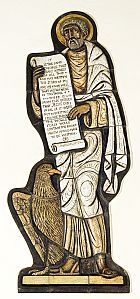GOSPEL READING

THE GOSPEL OF MATTHEW
The Genealogy: Mt 1,1-17
We have already looked closely at the first verse of the Gospel. This sets the scene for the genealogy which follows as well as for the whole Gospel. Now we read through the genealogy itself, 1-1-17. Note the various interruptions to the sequence of names.
Luke also gives a genealogy for Jesus and it's worth a look at Lk 5,33-38 so as to pick up the most obvious differences between the two. We will discover how Matthew and Luke use the genealogy and ancestry of Jesus for different purposes.
Then look at my response.
The Names: 1,2-16
We have looked at the first verse with its stress on the ancestry of Jesus back to David and Abraham. We can now see that these are picked up in reverse order: note where and how the names Christ, Abraham, David reappear: see verses 1,2; 1,6; 1,16.
For the style of the genealogy,look at Ruth 4,16-18. There are also long lists of genealogies elsewhere in the Old Testament, especially in the 1st book of Chronicles. What might be the purpose of such genealogies, especially in 1st Chronicles?
The traditional and literal translation is "begat". Modern translations prefer to render this as "was the father of...". Consider the difference.
There is no need for us to spend much time examining each name. As far as the Babylonian exile they are all to be found in the Old Testament. A full exploration would be a detailed overview of the history of Israel. There are some points we need to pick up:
Consider why the evangelist added "and his brothers" to Judah (1,3).
For verse 8, look at 1 Chronicles 3,11-12. What's missing?
Who are Asaph (1,7) and Amos (1,10)? Has your Bible changed these names to Asa and Amon? Any ideas what might be going on here?
What might be significant about the name of the father of Joseph (1,16)?
What about the women? Have a quick look at their stories: Tamar (1,3) in Genesis 38, Rahab (1,5) in Joshua 2, Ruth (1,5) in the book of her name, "the wife of Uriah" (Bathsheba) (1,6) in 2 Samuel 11). What is their significance? Why is Sarah the wife of Abraham not included? How do they prepare for Mary (1,16)?
Consider what's unusual about verse 16, the way it breaks the pattern. What is the relationship between Joseph and Jesus (and forget the old penny catechism answer!)
Now it is time for my response.
Matthew 1,17: the scheme.
Matthew in verse 17 stresses his pattern of three times fourteen generations. Count the names to see if the numbers are correct.
Look up the kings of Israel between Joram and Uzziah (1 Chronicles 3,11-12). Is someone missing?
Any idea why Matthew is so insistant on the number 14? Look at Daniel 9 for a clue. How is Jesus beginning a new period?
What do we learn about the nature of Matthew's genealogy from all this?
Another look at my response.
Pronunciation
Matthew's genealogy gives us a long list of names which are mostly unfamiliar. Some guide as to pronunciation may be helpful: there is often a tendency to panic when we are faced with strange words in the Bible. In fact, great accuracy is not needed when reading aloud because these words will be strange to most people.
In our Bibles, the names have been transliterated from Hebrew (via Greek) into English. English rules of punctuation therefore apply - such as they are, because English does not of course have the consistency of pronunciation of other languages, Welsh for example.
In pronouncing unfamiliar biblical names, it helps to divide the word into syllables. Hebrew generally has two types of syllable: open (consonant plus long vowel) or closed (consonant, short vowel, consonant).
"Jes-se" is well known, "Je-ho-sha-phat" less so; in Hebrew sh and ph are single letters. Try a few more for yourself, it helps to speak them out loud. Am-mi-na-dab
We are now ready to continue with the second part of the chapter, 1,18-25.
